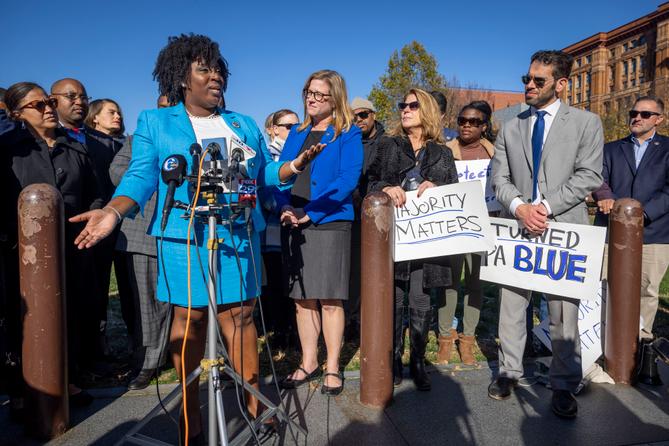Spotlight PA is an independent, nonpartisan newsroom powered by The Philadelphia Inquirer in partnership with PennLive/The Patriot-News, TribLIVE/Pittsburgh Tribune-Review, and WITF Public Media. Sign up for our free newsletters.
UPDATE, Nov. 17: Democrats win control of Pennsylvania state House after picking up 12 seats
Original story
HARRISBURG — Pennsylvania Democrats believe they will win enough state House seats after Tuesday’s midterm election to secure a majority when the legislature’s new session begins in January.
The party was expected to pick up several seats in the chamber after a redistricting cycle that produced new political lines that account for population shifts from GOP-leaning rural areas to suburban and urban areas populated by Democrats.
But unofficial results show that Democrats could flip or win a number of competitive, Republican-controlled seats in the suburbs of Pittsburgh, Philadelphia, and State College.
The Associated Press had yet to call many of the competitive races as of Wednesday afternoon, and litigation over certain ballots appeared likely, especially in very close races.
Still, at a celebratory press conference in Philadelphia the day after the election, leaders of the party — which hasn’t controlled the state House since 2010 — claimed victory.
“We’ve had an agenda to defend democracy for a long time, and we finally will get ready to enact it as we go into 2023,” said state House Democratic Leader Joanna McClinton of Philadelphia.
Where the balance stands
The Pennsylvania House has 203 members: 113 Republicans and 90 Democrats currently.
On Tuesday, Republicans appeared to have flipped four seats, including one held by a longtime incumbent and others by retiring Blue Dog (or moderate) Democrats.
Democrats, meanwhile, anticipate they will pick up at least 15 seats currently held by GOP lawmakers, according to social media posts by the party’s state House campaign arm and Democratic sources.
Such victories would give Democrats 101 lawmakers — one shy of a majority.
In order to secure the majority, Democratic candidates seemingly need to win in the 142nd and 151st Districts, where the margins are currently razor-thin.
The 142nd District in Bucks County was formerly held by Republican state Rep. Frank Farry, who successfully ran for a state Senate seat on Tuesday, according to unofficial results.
As of Wednesday afternoon, Republican Joseph Hogan had a 3-vote lead over Democrat Mark Moffa there, according to unofficial results.
In the 151st District in Montgomery County, Republican state Rep. Todd Stephens had a 26-vote lead over Democrat Melissa Cerrato as of Wednesday afternoon, according to unofficial results.
Both counties had processed all in-person votes and mail ballots Wednesday, leaving only overseas ballots that arrive through next Tuesday and provisional ballots — those cast by a voter whose eligibility was in question on Election Day.
But there’s another variable that could affect the outcome of these races: whether a federal judge reverses a state ruling that directed officials to set aside undated or incorrectly dated mail ballots.
It’s unclear whether and how many of those ballots were cast in these races. Bucks County could not provide a number, and Montgomery County reported about 4,300 mail ballots needed further evaluation.
In the wake of the state Supreme Court ruling against the counting of undated ballots, some counties began proactively reaching out to voters about the issues and allowing them to fix their ballots. Other counties did not.
The Pennsylvania Department of State, as well as groups including Turn PA Blue, a grassroots Democratic political organization, advised voters who believed they had made a mistake on their mail ballot to cast a provisional ballot as a safeguard. Those provisional ballots would be counted only if a mail ballot were deemed invalid.
Jamie Perrapato, executive director of Turn PA Blue, said she expects many provisional ballots to favor Democrats because members of the party vote by mail in greater numbers than Republicans.
The Inquirer reported Wednesday that the Republican National Committee plans to challenge the legality of provisional ballots cast in person by individuals who realized they had previously submitted a mail ballot that had a disqualifying defect, like a lack of a signature or date.
A legal decision agreeing with the RNC could hurt Democrats’ odds in close races, Perrapto said.
“When you’re talking about three votes and 26 votes, everything comes into play.”

New legislative maps in action
Every 10 years, states redraw their political lines to account for population changes.
Tuesday was the first general election in Pennsylvania with new state House and Senate maps, which political scientist and Republican consultant Sam Chen said were key in shifting the balance of power.
He added that Democratic candidates for statewide office, in particular gubernatorial winner Josh Shapiro, might have brought out more voters.
“Top of the ticket matters,” said Chen. “This is a year where Republicans did not put strong candidates on the top of the ticket in Doug Mastriano and Mehmet Oz.”
Earlier this year, a five-member panel of four legislative leaders and one nonpartisan chair voted to approve the new state House and Senate maps.
Ahead of the election, advocates for a more transparent redistricting process said they expected the maps, especially the lower chamber’s, would better reflect the partisan makeup of the state. That appears to have played out Tuesday.
Take Chester County outside of Philadelphia. Six of the eight state House races that include the area were separated by roughly 1,000 votes as of Wednesday morning.
Those close races properly reflect the changing suburban population of the area, said Justin Villere of Draw the Lines PA, a project of the good-government group the Committee of Seventy.
“Chester County has been trending Democratic but is still a hotly contested county,” said Villere. “So you’ve got multiple races that are really, really close and that wouldn’t have happened before these new maps.”
The new maps decreased the overall number of competitive districts, which are areas where neither major party has an overwhelming majority.
Many of the newly drawn districts have either a strong Democratic or Republican lean, strengthening one party’s hold on the seat over the other. One lawmaker who lost Tuesday said he fears this will further polarize the legislature and encourage partisanship.
“Outcome-based maps — the worst kind of gerrymandering — decided this race,” state Rep. Chris Quinn (R., Delaware) said in a text message. “I fear that the end result will be increased partisanship and gridlock in the legislature for years to come.”
What comes next
The state House has three session days scheduled for next week. Lawmakers in both parties will choose their leaders for the next term in a closed-door vote at that time.
The state House will swear in its new members Jan. 3 and elect a new speaker — the highest position and one meant to represent all lawmakers, not just fellow party members.
Democrats will likely nominate McClinton for the position. She’d be the first woman to run the chamber and the highest-ranking woman in the history of the Pennsylvania General Assembly.
Securing a majority would give Democrats the power to set the chamber’s agenda in 2023, an increasingly likely outcome that has come as a surprise to many inside and outside the party.
They would have more leverage than they’ve had in a decade to advance policy goals. (The state Senate will remain under Republican control.)
The party would also be able to block controversial constitutional amendments from reaching voters, such as a Republican-proposed omnibus package that would amend the state’s founding document to say it does not protect abortion rights.
Should they take the majority, Democrats have a number of long-simmering priorities to juggle, including marijuana legalization, raising the minimum wage, and enshrining LGBTQ nondiscrimination in state law.
“Our leadership team will be presiding over a center-left majority, and not a left-left majority,” state Rep. Peter Schweyer (D., Lehigh) told Spotlight PA. “And so we’re going to be pushing progressive values, but at the same time be mindful that this is, in fact, a purple state.”
WHILE YOU’RE HERE… If you learned something from this story, pay it forward and become a member of Spotlight PA so someone else can in the future at spotlightpa.org/donate. Spotlight PA is funded by foundations and readers like you who are committed to accountability journalism that gets results.
